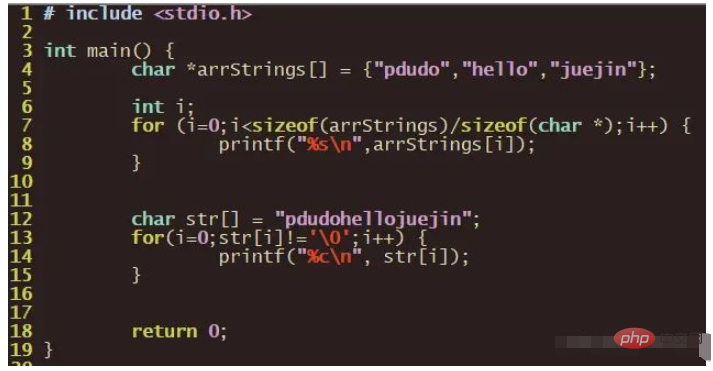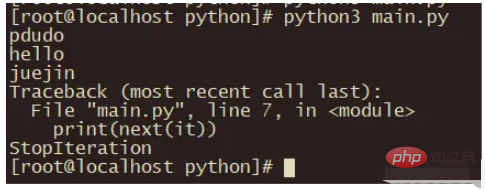How to create an iterator in Python?
What is an iterator
What ispythonIterator? Let’s take the simplest example:
list1 = ["pdudo","juejin","hello"]
tuple1 = ("pdudo","juejin","hello")
dict1 = {"name":"pdudo"}
for i in list1:
print(i)
for i in tuple1:
print(i)
for i in dict1:
print(i)This is the python iterator. Okay, that’s it, let’s do it manually.
Yes, using the for...in method, the bottom layer uses iterators. When you wrote before, you were never curious about why you traverse different All data types can be used for...in is universal?
My brother, I am the same. I have never thought about why it can be written like this. We have already talked about the iterator syntax. Next, let’s peel off the veil of iterators.
Why an iterator is needed
As long as it meets the python iterator conditions, you can use for...in to traverse elements, that is: Use the same code to traverse different data containers. I think this is the root cause.
If the above description is not clear, we can use c and python to traverse the array and string, and we will have a clear understanding.

The above code is c language traversing array"pdudo","hello","juejin"and stringpdudohellojuejin, we need to write the critical value of the traversal condition ourselves.
And how to use python to write it? Let’s take a look.
list1 = ["pdudo","hello","juejin"]
char1 = "pdudohellojuejin"
for v in list1:
print(v)
for c in char1:
print(c)You only need to define the array and string, and then use for...in and you are done.
I think the above example is enough to prove why you should use iterators, because it’s really fun.
How iterators work
After going through the first two paragraphs, I guess you must want to know how iterators work, right? Now it's here.
When using the for...in statement, it will call the inter() object, which will return an iterator object. The object also defines the __next__() method, which returns one container element at a time. When no more elements can be returned, a StopIteration exception will be thrown to indicate for Terminate the loop.
Still don’t understand? It doesn’t matter, let’s write another case to illustrate.
list1 = ["pdudo","hello","juejin"] it = iter(list1) print(next(it)) print(next(it)) print(next(it)) print(next(it))
The above code defines a list whose values are: "pdudo", "hello", "juejin", and then calls the iter method, which will return an iterator, and then The next method is called to return the next element, but the length of the list we defined is 3, and the next method is called 4 times. It can be seen that the last time an exception will be thrown.
After we execute, the effect is as follows:

It can be seen that it is consistent with our above guess, in the for...in statement , the inter() container object is also called, and __next__ is used to return subsequent iterable objects, and so on, until an exception StopIteration is encountered and the loop ends.
Okay, do you know how iterators work? So, let’s throw another question to see if you can answer it? How to determine if a data type can be iterated?
How to create an iterator
We have learned how to use iterators and know how iterators work. This paragraph will introduce how to create an iterator. Before looking at this , let’s think about a question, will the following code report an error?
a = 9527
for i in a:
print(i)We use for...in to traverse a int type of data.
The above code will of course report an error, which leads to our knowledge point: What kind of data type can be iterated?
is like this. Whether it can be iterated depends on whether the method has a __iter__ method.
You can look at the following example. We have customized an iterator for flashback output data.
#!/bin/env python
class flashBack:
def __init__(self,list1):
self.data = list1
self.index = len(list1)-1
def __iter__(self):
return self
def __next__(self):
if self.index < 0:
raise StopIteration
val = self.data[self.index]
self.index = self.index - 1
return val
def main():
list1 = [1,2,3,4,5]
tuble1 = ("pdudo","juejin","hello")
for i in flashBack(list1):
print(i)
for i in flashBack(tuble1):
print(i)
if __name__ == '__main__':
main()After execution, the result is:

It can be seen that to create an iterator, at least the __iter__ method and are required __next__ method.
Okay, with this basic case, let’s write a linked list?
#!/bin/env python
class Node:
def __init__(self,val):
self.val = val
self.nextNode = None
class Lists:
def __init__(self,currentNodes):
self.currentNode = currentNodes
def __iter__(self):
return self
def __next__(self):
if self.currentNode is None:
raise StopIteration
v = self.currentNode.val
self.currentNode = self.currentNode.nextNode
return v
def main() :
node1 = Node(1)
node2 = Node(2)
node3 = Node(3)
node1.nextNode = node2
node2.nextNode = node3
for i in Lists(node1):
print(i)
if __name__ == '__main__':
main()As shown in the above code, we first create the node Node, which has 2 values, val is the recorded value, and nextNode is the record The pointer to the next Node, and then defines the class Lists. When calling, you need to pass in a Node, which will currentNodes Record the current Node. Focus on __next__. When the current node is empty, StopIteration is returned to inform for that the iterator is over. Otherwise, take out the val of the current node and return it, and slide it down to the next node.
The above code, after running, the results are as follows:

The above is the detailed content of How to create an iterator in Python?. For more information, please follow other related articles on the PHP Chinese website!

Hot AI Tools

Undresser.AI Undress
AI-powered app for creating realistic nude photos

AI Clothes Remover
Online AI tool for removing clothes from photos.

Undress AI Tool
Undress images for free

Clothoff.io
AI clothes remover

AI Hentai Generator
Generate AI Hentai for free.

Hot Article

Hot Tools

Notepad++7.3.1
Easy-to-use and free code editor

SublimeText3 Chinese version
Chinese version, very easy to use

Zend Studio 13.0.1
Powerful PHP integrated development environment

Dreamweaver CS6
Visual web development tools

SublimeText3 Mac version
God-level code editing software (SublimeText3)

Hot Topics
 Is the conversion speed fast when converting XML to PDF on mobile phone?
Apr 02, 2025 pm 10:09 PM
Is the conversion speed fast when converting XML to PDF on mobile phone?
Apr 02, 2025 pm 10:09 PM
The speed of mobile XML to PDF depends on the following factors: the complexity of XML structure. Mobile hardware configuration conversion method (library, algorithm) code quality optimization methods (select efficient libraries, optimize algorithms, cache data, and utilize multi-threading). Overall, there is no absolute answer and it needs to be optimized according to the specific situation.
 Is there any mobile app that can convert XML into PDF?
Apr 02, 2025 pm 08:54 PM
Is there any mobile app that can convert XML into PDF?
Apr 02, 2025 pm 08:54 PM
An application that converts XML directly to PDF cannot be found because they are two fundamentally different formats. XML is used to store data, while PDF is used to display documents. To complete the transformation, you can use programming languages and libraries such as Python and ReportLab to parse XML data and generate PDF documents.
 How to convert XML files to PDF on your phone?
Apr 02, 2025 pm 10:12 PM
How to convert XML files to PDF on your phone?
Apr 02, 2025 pm 10:12 PM
It is impossible to complete XML to PDF conversion directly on your phone with a single application. It is necessary to use cloud services, which can be achieved through two steps: 1. Convert XML to PDF in the cloud, 2. Access or download the converted PDF file on the mobile phone.
 What is the function of C language sum?
Apr 03, 2025 pm 02:21 PM
What is the function of C language sum?
Apr 03, 2025 pm 02:21 PM
There is no built-in sum function in C language, so it needs to be written by yourself. Sum can be achieved by traversing the array and accumulating elements: Loop version: Sum is calculated using for loop and array length. Pointer version: Use pointers to point to array elements, and efficient summing is achieved through self-increment pointers. Dynamically allocate array version: Dynamically allocate arrays and manage memory yourself, ensuring that allocated memory is freed to prevent memory leaks.
 How to control the size of XML converted to images?
Apr 02, 2025 pm 07:24 PM
How to control the size of XML converted to images?
Apr 02, 2025 pm 07:24 PM
To generate images through XML, you need to use graph libraries (such as Pillow and JFreeChart) as bridges to generate images based on metadata (size, color) in XML. The key to controlling the size of the image is to adjust the values of the <width> and <height> tags in XML. However, in practical applications, the complexity of XML structure, the fineness of graph drawing, the speed of image generation and memory consumption, and the selection of image formats all have an impact on the generated image size. Therefore, it is necessary to have a deep understanding of XML structure, proficient in the graphics library, and consider factors such as optimization algorithms and image format selection.
 How to convert xml into pictures
Apr 03, 2025 am 07:39 AM
How to convert xml into pictures
Apr 03, 2025 am 07:39 AM
XML can be converted to images by using an XSLT converter or image library. XSLT Converter: Use an XSLT processor and stylesheet to convert XML to images. Image Library: Use libraries such as PIL or ImageMagick to create images from XML data, such as drawing shapes and text.
 How to open xml format
Apr 02, 2025 pm 09:00 PM
How to open xml format
Apr 02, 2025 pm 09:00 PM
Use most text editors to open XML files; if you need a more intuitive tree display, you can use an XML editor, such as Oxygen XML Editor or XMLSpy; if you process XML data in a program, you need to use a programming language (such as Python) and XML libraries (such as xml.etree.ElementTree) to parse.
 Recommended XML formatting tool
Apr 02, 2025 pm 09:03 PM
Recommended XML formatting tool
Apr 02, 2025 pm 09:03 PM
XML formatting tools can type code according to rules to improve readability and understanding. When selecting a tool, pay attention to customization capabilities, handling of special circumstances, performance and ease of use. Commonly used tool types include online tools, IDE plug-ins, and command-line tools.






